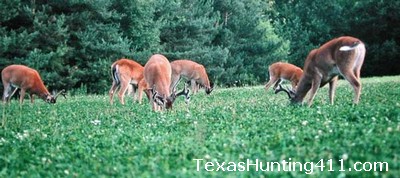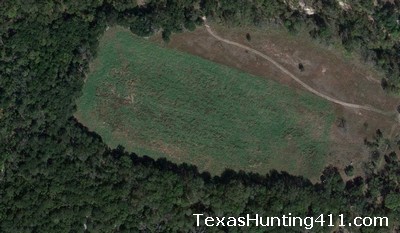Food plots are probably the best way to attract wildlife, provide additional foods for them, and increase harvest opportunities in Texas. Every animal needs food, cover, water and space to survive. When combined with wildlife management and habitat enhancement, food plots are a great management practice for white-tailed deer, wild turkey, bobwhite quail, and doves. They can also work for waterfowl, but most food plots in Texas are used for white-tailed deer forage production and specifically for deer hunting.
There are several choices when it comes to food plots, but one must first decided what seeds to plant and when. Next, hunters and landowners have to choose between seeding perennial or annual plants, as well as warm or cool season plots. Warm season food plots are planted to grow during the spring and summer, while cool season plantings are food plots that grow during the fall and winter. In most places, Texas included, fall and winter food plots outnumber spring food plots. This is because rainfall is more predictable during the fall into the winter, so plots are generally more successful. The other reason is because many winter food plots serve as hunting plots during the whitetail season.

Even though whitetail deer get the lion’s share of the attention when it comes to food plots in Texas, plantings for upland game birds such as quail and dove are quite popular. They can also be very effective at providing supplemental food and excellent hunting opportunities. Grain sorghum (milo), millet and black oil sunflowers are great plantings for mourning and white-winged doves. However, it’s important to note federal regulations regarding the definition of baiting for migratory bird species. Make sure you are familiar with these laws before planting, but especially before hunting, these types of food plots.
The same can be said of food plots for ducks and geese in Texas. These two are migratory bird species and are subject the same hunting and baiting regulations. There is a fine line between what is labeled crop and what is labeled bait. Any plant that produces a seed/grain will attract ducks and geese. However, the key for ducks is that these plantings be flooded. They do not have to be, but flooded fields with 6 to 12 inches of water are much more attractive to ducks. Geese, on the other hand, are much more prone to visit upland areas to feed.
Native plants also make for great food plots. In fact, they may be the very best in most cases. That is because native plants are well-adapted to Texas soils, and wildlife are accustomed to eating them. Perennials make for great wildlife plots. Seeds of several high quality, perennial native plant species including Engelmann daisy, Maxillian sunflower, bush sunflower, and Illinois bundleflower make for great plots, especially when used in combination in a seed mix. Perennial food plots are great for both wildlife as well as landowners/hunters because perennial plants provide permanent vegetative cover, except for during the winter some species die back, and do not have to be replanted every year.
Perennial plots are more expensive to establish, but the the cost can be made back through not having to replant each year. Perennial food plots, however, are not always the best choices for certain wildlife species, landowners or properties. For example, perennial food plots produce less forage on an seasonal basis for whitetail deer than annual food plots, which can included plants such as iron and clay cowpeas, soybeans, lablab, or clovers.
Legumes, such as peas, clovers and alfalfa make for outstanding whitetail deer food plots because they are well suited for many Texas soils and they have a high protein content. Not only do legumes have 20 to 30 percent protein levels, but these plants can fix nitrogen into the soil, enhancing the growth of other plants during other seasons. Warm season legumes and other spring food plots in Texas can be planted from late March to mid-April.
It was mentioned prior that fall and winter food plots for deer hunting are the most popular wildlife plantings in Texas. Though hunting plots are typically smaller than forage plots, they do provide additional forage for deer—and often turkey too—as well as attract animals for harvest. These fall plots are most commonly planted to cool season annuals such as wheat, oats, and rye. Many landowners will begin planting fall plots in early September, but they can be planted anytime throughout the month. The best plan is to seed annuals right before a forecasted rainfall event, which is often associated with a cool front. Cool season annuals can also be overseeded (broadcast) in pastures and fields adjacent wood lines and brush lines, where deer like to forage.

There is no shortage of desirable plants that are well suited for food plots for a variety of wildlife species. But a common question among Texas hunters is, “How many food plots for deer do I plant, and how big should they be?” There is no simple answer that will work in every situation, but some general rules of thumb may help. If the plots are primarily intended to be hunted during the deer hunting season, then you really can not have too many. Just keep in mind that whitetail can feed in any one of them, regardless of where you, the hunter, is located. Small plots work great around stand setups. Food plots strictly for hunting should be at least 1/4 acre in size.
Properties interested in providing supplemental food for whitetail deer management will have more interest in forage plots. In general, forage plots on Texas ranches should comprise anywhere from two to six percent of the the total acreage. As for size, it would be ideal to have a two to six acre plot for every 100 acres of land, but larger plots can be established to service larger areas, such as a single four to 12 acre plot for 200 acres of area/habitat. Research in Texas suggest that a one acre food plot that produces 3,000 pounds of forage per acre will provide 15 deer-months of food. In other words, this quantity of forage on one acre will feed five deer for three months, three deer for five months, or theoretically, 15 deer for one month.
When it comes to food plot shape, it’s best to plant plots into long rectangular shapes rather than big squares. However, food plot shape is often dictated by the orientation of the open area selected for planting. When possible, create food plots that are three to four times longer than they are wide. Although deer prefer smaller plots, it takes more time and effort to create four, three acre plots than it does to create two, six acre plots. It takes even less time to create a single 12 acre food plot. Whitetail deer will use food plots of any size, but will be hesitant to feed far away from cover in the middle of very large plots. Deer prefer to feed along plot edges, only moving to the center of large food plots (often in low light or after dark) once the perimeter has been consumed. This is why plots that are linear in shape are best for whitetail.
To sum up, food plots are a great way to provide supplemental foods for wildlife and attract animals for harvest. Although food plots can be established for almost any game animal, most food plots in Texas are planted for whitetail deer. In general, fall and winter food plots are more popular than spring/summer plots for deer, in a large part due to the deer hunting season. Fall plots also tend to be more successful, with more predictable rainfall occurring later in the year. When combined with habitat management activities, food plots are a great management practice for deer, wild turkey, quail, and doves, but know your objectives before you plant.